Analysis of Fired Equipment within the Framework of Low-Cost Modelling Systems
Abstract
:1. Introduction
Fired Equipment and Maldistribution Issues
- an economizer—serves to heat feed water, it is usually situated in areas with a lower flue gas temperature;
- an evaporator—tube-side fluid changes phase in this heat exchanger, which is often integrated into the membrane walls of the radiant and convection sections;
- a superheater—production of superheated steam that is used for a particular process or power application is finalised in this heat exchanger. It usually forms the first heat transfer surface in the convection section, but it is frequently installed above the radiant chamber.
2. Overview of the Modelling Approaches
3. Proposed Calculation Framework
- a radiant section—i.e., to evaluate the amount of radiant heat duty, the main dimensions of the radiant chamber and the tubular system;
- a convection section—among other things, to design the main parameters of tubular heat exchangers (number of tubes, tube geometry, etc.), average input, output temperatures and heat duty.
4. Case Study
4.1. Industrial Boiler
4.2. Low-Cost Modelling of the Radiant Section
4.3. Low-Cost Modelling of the Convection Tube Bank
θout,2[i, j] = (1 − R1[i, j] · P1[i, j]) × θout,2[i, j − 1] + R1[i, j] · P1[i, j] × θout,1[i − 1, j]
5. Conclusions
Author Contributions
Funding
Acknowledgments
Conflicts of Interest
References
- Gómez, A.; Fueyo, N.; Díez, L.I. Modelling and simulation of fluid flow and heat transfer in the convective zone of a power-generation boiler. Appl. Therm. Eng. 2008, 28, 532–546. [Google Scholar] [CrossRef] [Green Version]
- Hájek, J.; Jegla, Z. Standards for fired heater design: Analysis of two dominant heat flux variation factors. Appl. Therm. Eng. 2017, 125, 702–713. [Google Scholar] [CrossRef]
- Stehlík, P. Conventional versus specific types of heat exchangers in the case of polluted flue gas as the process fluid—A review. Appl. Therm. Eng. 2011, 31, 1–13. [Google Scholar] [CrossRef]
- API, Standard 530. Calculation of Heater-tube Thickness in Petroleum Refineries, 6th ed.; American Petroleum Institute: Washington, DC, USA, 2008. [Google Scholar]
- API, Standard 560. Fired Heaters for General Refinery Service, 4th ed.; American Petroleum Institute: Washington, DC, USA, 2007. [Google Scholar]
- Jegla, Z.; Kohoutek, J.; Stehlík, P. Design and operating aspects influencing fouling inside radiant coils of fired heaters operated in crude oil distillation plants. In Proceedings of the Heat Exchanger Fouling and Cleaning IX, Crete Island, Greece, 5–10 June 2011; Malayeri, M.R., Müller-Steinhagen, H., Watkinson, A.P., Eds.; pp. 7–14. [Google Scholar]
- Jegla, Z. Innovative adaptation of MPF model to recognition of thermal behaviour of operated industrial low emission burner system. Chem. Eng. Trans. 2016, 52, 667–672. [Google Scholar] [CrossRef]
- Jegla, Z.; Kilkovský, S.; Turek, V. Novel approach to proper design of combustion and radiant chambers. Appl. Therm. Eng. 2016, 105, 876–886. [Google Scholar] [CrossRef]
- Baukal, C.E. The John Zink Hamworthy Combustion Handbook: Volume 1—Fundamentals, 2nd ed.; CRC Press: Boca Raton, FL, USA, 2013; ISBN 9781439839621. [Google Scholar]
- Jegla, Z.; Fialová, D. Development of heat and fluid flow distribution modelling system for analysing multiple-distributed designs of process and power equipment. Chem. Eng. Trans. 2018, 70, 1471–1476. [Google Scholar] [CrossRef]
- Nekvasil, R.; Jegla, Z. Boiler reheater chamber cracking analysis. All Power 2014, 5, 11–13. [Google Scholar]
- Aslam Bhutta, M.M.; Hayat, N.; Bashir, M.H.; Khan, A.R.; Ahmad, K.N.; Khan, S. CFD applications in various heat exchangers design: A review. Appl. Therm. Eng. 2012, 32, 1–12. [Google Scholar] [CrossRef]
- Turek, V.; Fialová, D.; Jegla, Z. Efficient flow modelling in equipment containing porous elements. Chem. Eng. Trans. 2016, 52, 487–492. [Google Scholar] [CrossRef]
- Gandhi, M.S.; Ganguli, A.A.; Joshi, J.B.; Vijayan, P.K. CFD simulation for steam distribution in header and tube assemblies. Chem. Eng. Res. Des. 2012, 90, 487–506. [Google Scholar] [CrossRef]
- Zhou, J.; Sun, Z.; Ding, M.; Bian, H.; Zhang, N.; Meng, Z. CFD simulation for flow distribution in manifolds of central-type compact parallel flow heat exchangers. Appl. Therm. Eng. 2017, 126, 670–677. [Google Scholar] [CrossRef]
- Poursaeidi, E.; Arablu, M. Using CFD to study combustion and steam flow distribution effects on reheater tubes operation. J. Fluids Eng. 2011, 133, 051303:1–051303:11. [Google Scholar] [CrossRef]
- Jegla, Z.; Vondál, J.; Hájek, J. Standards for fired heater design: An assessment based on computational modelling. Appl. Therm. Eng. 2015, 89, 1068–1078. [Google Scholar] [CrossRef]
- Galindo-García, I.F.; Vázquez-Barragán, A.K.; Rossano-Román, M. CFD simulations of heat recovery steam generators including tube banks. In Proceedings of the ASME 2014 Power Conference (POWER 2014), Baltimore, MD, USA, 28–31 July 2014; POWER2014-32261. pp. 1–9. [Google Scholar] [CrossRef]
- Naď, M.; Jegla, Z.; Létal, T.; Lošák, P.; Buzík, J. Thermal load non-uniformity estimation for superheater tube bundle damage evaluation. MATEC Web Conf. 2018, 157, 02033:1–02033:10. [Google Scholar] [CrossRef]
- Manickam, M.; Schwarz, M.P.; Perry, J. CFD modelling of waste heat recovery boiler. Appl. Math. Model. 1998, 22, 823–840. [Google Scholar] [CrossRef]
- Lan, J.; Zhu, L.; Zhao, J. Modeling and Analysis of Cross-Flow Heat Exchanger Based on the Distributed Parameter Method. In Proceedings of the ASME 2012 International Mechanical Engineering Congress & Exposition (IMECE 2012), Houston, TX, USA, 9–15 November 2012; IMECE2012-86235. pp. 417–425. [Google Scholar] [CrossRef]
- Gaddis, E.S. Effectiveness of multipass shell-and-tube heat exchangers with segmental baffles (cell method). In Heat Exchanger Design Handbook; Hewitt, G.F., Ed.; Begell House: New York, NY, USA, 1998; ISBN 1-56700-094-0. [Google Scholar]
- Shah, R.K.; Sekulić, D.P. Fundamentals of Heat Exchanger Design; John Wiley & Sons: Hoboken, NJ, USA, 2003; pp. 256–258. ISBN 0-471-32171-0. [Google Scholar]
- Bajura, R.A.; Jones, E.H. Flow Distribution Manifolds. J. Fluids Eng. 1976, 98, 654–665. [Google Scholar] [CrossRef]
- Bailey, B.J. Fluid flow in perforated pipes. J. Mech. Eng. Sci. 1975, 17, 338–347. [Google Scholar] [CrossRef]
- Ngoma, G.D.; Godard, F. Flow distribution in an eight level channel system. Appl. Therm. Eng. 2005, 25, 831–849. [Google Scholar] [CrossRef]
- Cho, E.S.; Choi, J.W.; Yoon, J.S.; Kim, M.S. Modeling and simulation on the mass flow distribution in microchannel heat sinks with non-uniform heat flux conditions. Int. J. Heat Mass Transf. 2010, 53, 1341–1348. [Google Scholar] [CrossRef]
- Baek, S.; Lee, C.; Jeong, S. Effect of flow maldistribution and axial conduction on compact microchannel heat exchanger. Cryogenics 2014, 60, 49–61. [Google Scholar] [CrossRef]
- Cabezas-Gómez, L.; Navarro, H.A.; Saiz-Jabardo, J.M. Thermal performance of multipass parallel and counter-cross-flow heat exchangers. J. Heat Transf. 2007, 129, 282–290. [Google Scholar] [CrossRef]
- Pignotti, A.; Shah, R.K. Effectiveness-number of transfer units relationships for heat exchanger complex flow arrangements. Int. J. Heat Mass Transf. 1992, 35, 1275–1291. [Google Scholar] [CrossRef]
- Lobo, W.E.; Evans, J.E. Heat transfer in radiant section of petroleum heaters. Trans. Am. Inst. Chem. Eng. 1939, 35, 743–751. [Google Scholar]
- Jegla, Z.; Hájek, J.; Vondál, J. Numerical analysis of heat transfer in radiant section of fired heater with realistic imperfect geometry of tube coil. Chem. Eng. Trans. 2014, 39, 889–894. [Google Scholar] [CrossRef]
- Li, C.; Hu, G.; Zhong, W.; Cheng, H.; Du, W.; Qian, F. Comprehensive simulation and optimization of an ethylene dichloride cracker based on the one-dimensional Lobo–Evans method and computational fluid dynamics. Ind. Eng. Chem. Res. 2013, 52, 645–657. [Google Scholar] [CrossRef]
- Morales-Fuentes, A.; Polley, G.T.; Picón-Núñez, M.; Martínez-Martínez, S. Modeling the thermo-hydraulic performance of direct fired heaters for crude processing. Appl. Therm. Eng. 2012, 39, 157–162. [Google Scholar] [CrossRef]
- Hewitt, G.F.; Shires, G.L.; Bott, T.R. Process Heat Transfer, 1st ed.; CRC Press: Boca Raton, FL, USA, 1994; ISBN 9780849399183. [Google Scholar]
- Tucker, R.; Ward, J. Identifying and quantifying energy savings on fired plant using low cost modelling techniques. Appl. Energy 2012, 89, 127–132. [Google Scholar] [CrossRef]
- Jegla, Z. Development of modified plug-flow furnace model for identification of burner thermal behavior. Chem. Eng. Trans. 2013, 35, 1195–1200. [Google Scholar] [CrossRef]
- Jegla, Z.; Horsák, J.; Turek, V.; Kilkovský, B.; Tichý, J. Validation of developed modified plug-flow furnace model for identification of burner thermal behaviour. Chem. Eng. Trans. 2015, 45, 1189–1194. [Google Scholar] [CrossRef]
- Ptáčník, R. Analysis, Synthesis, and Retrofit Design of Heat Exchanger Networks Containing Multipass Crossflow Heat Exchangers. Ph.D. Thesis, Brno University of Technology, Brno, Czech Republic, 1991. [Google Scholar]
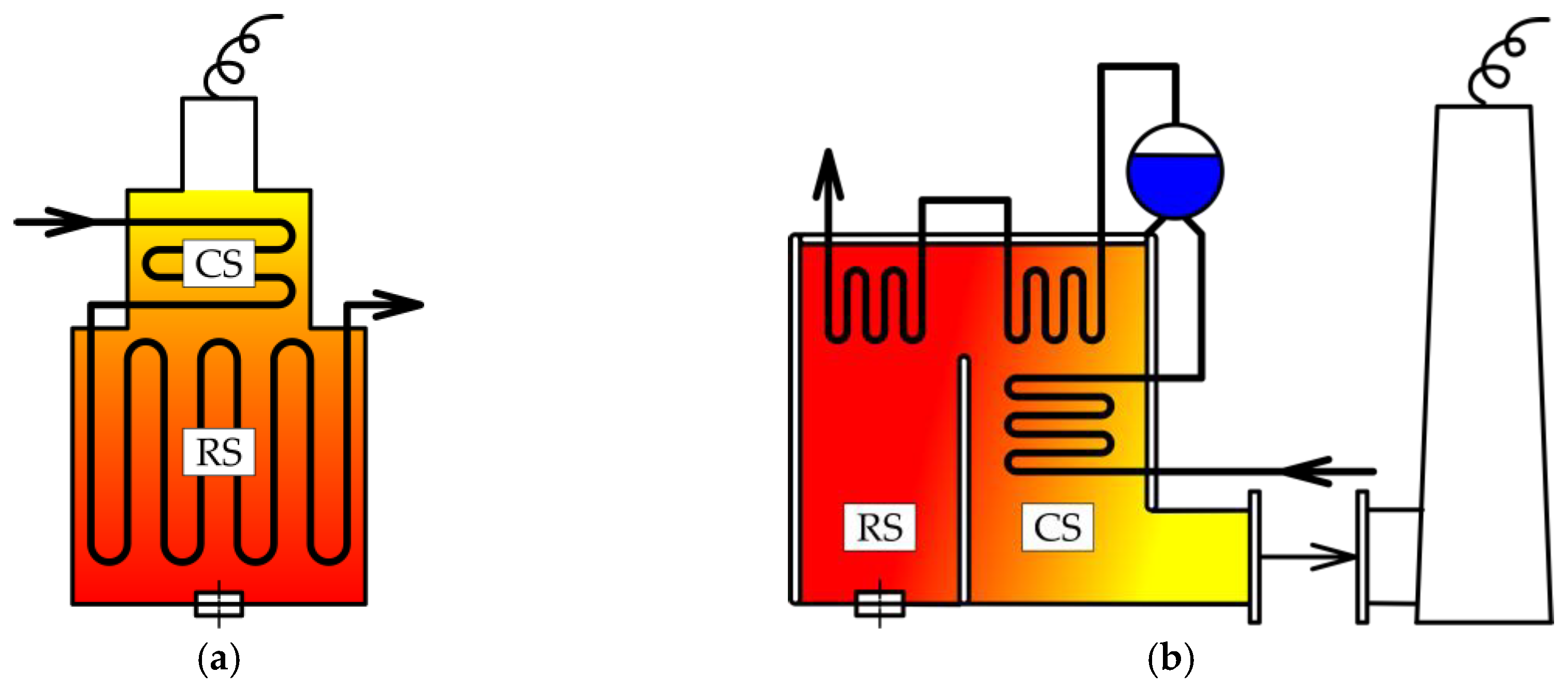

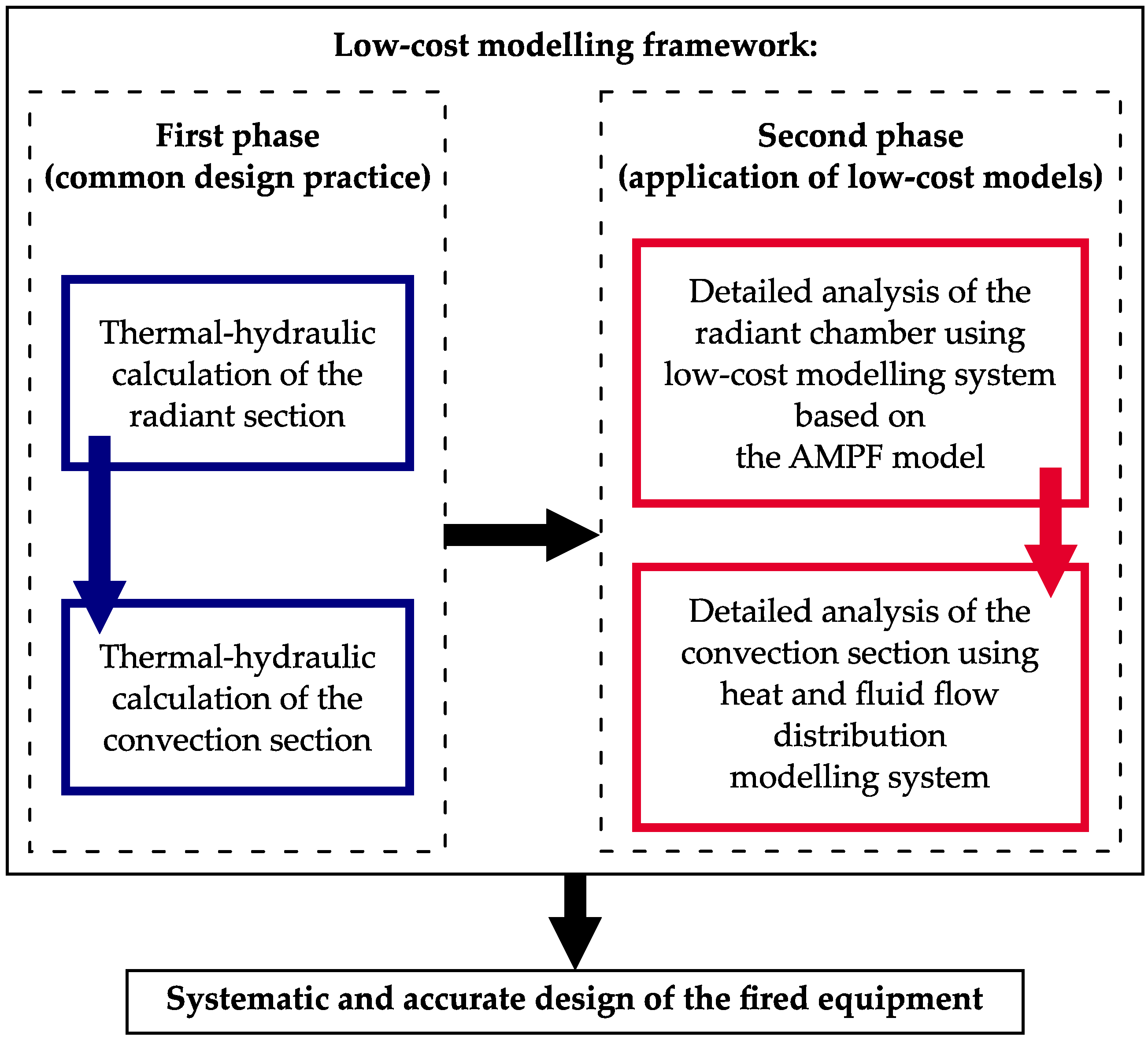
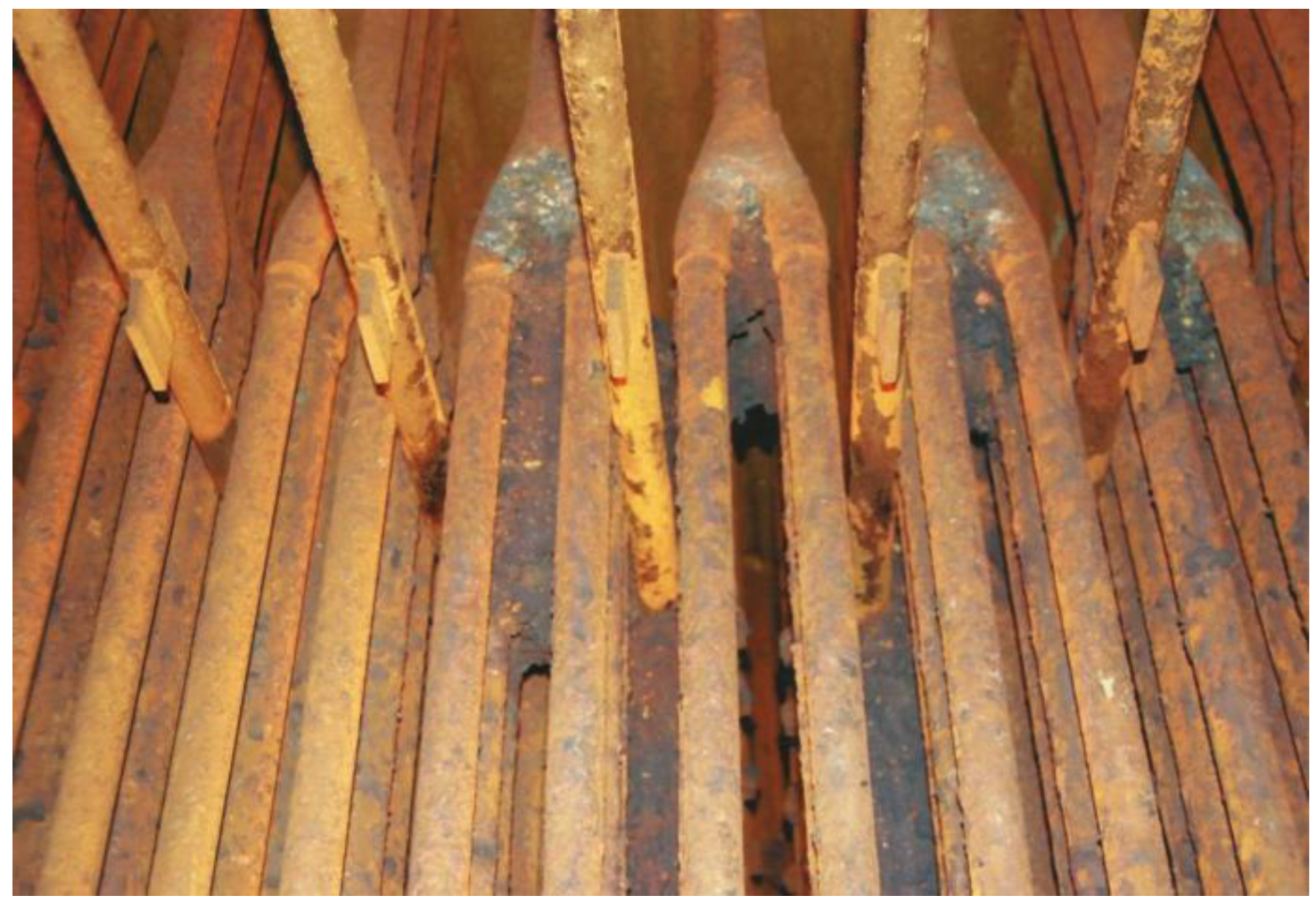
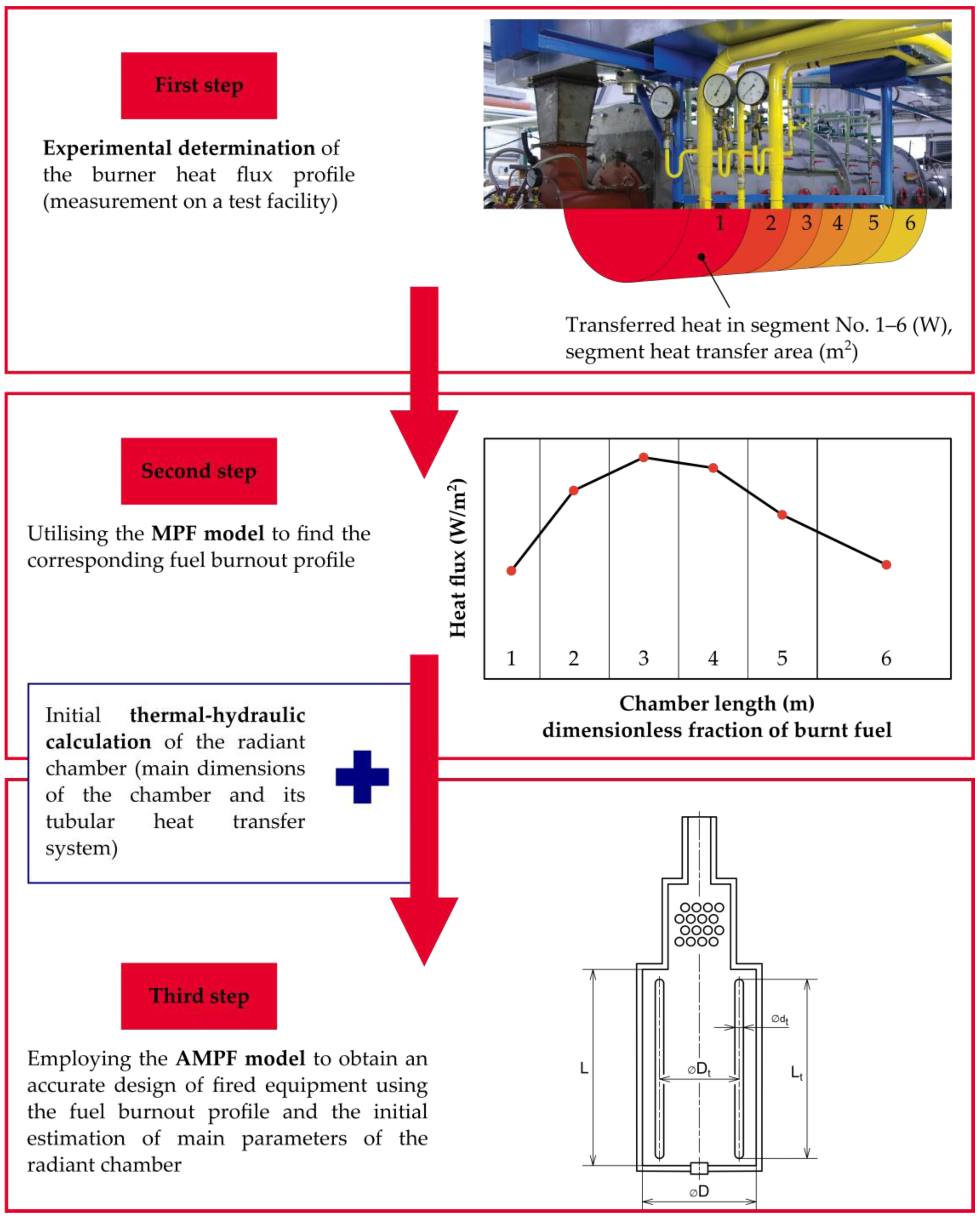
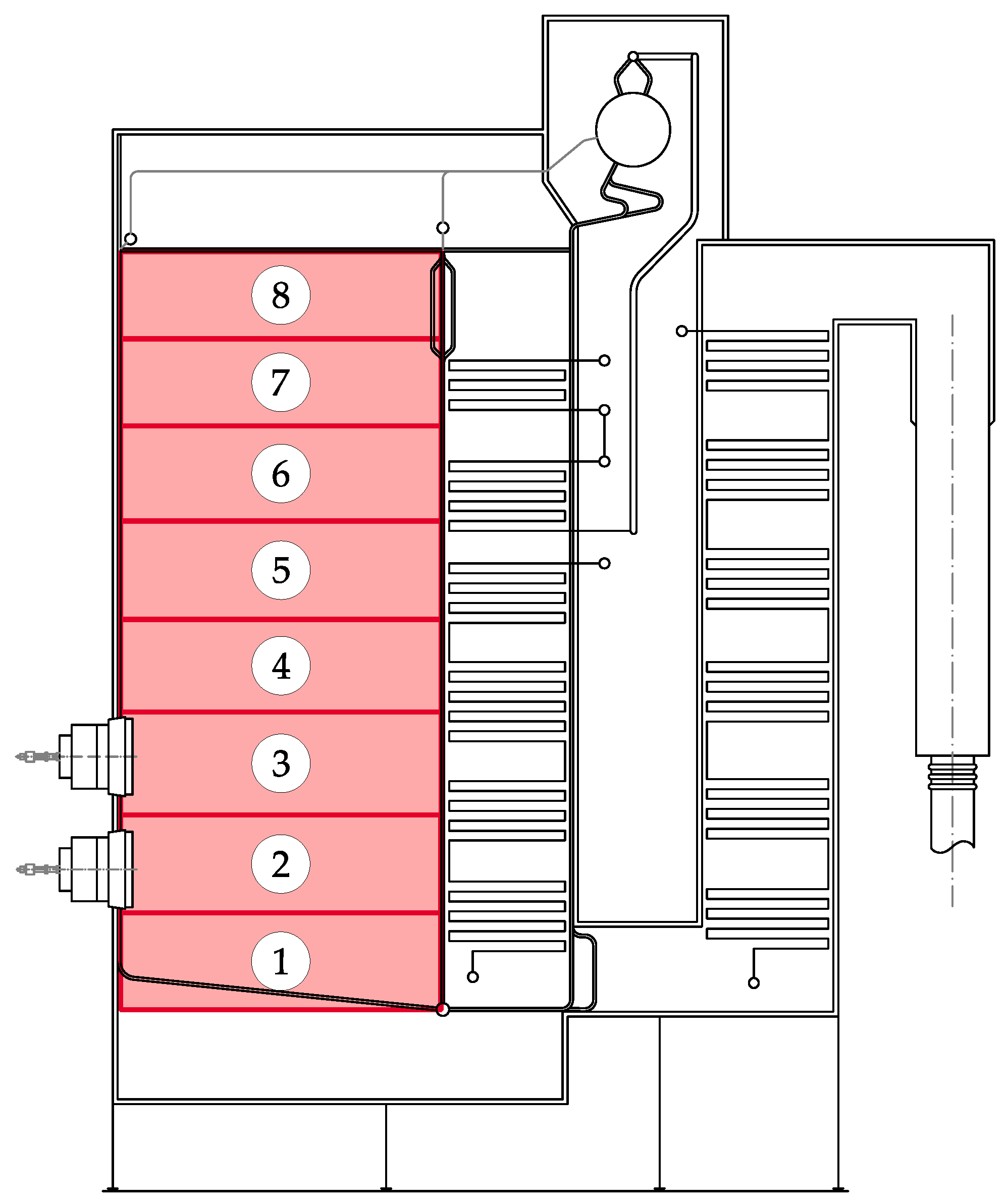

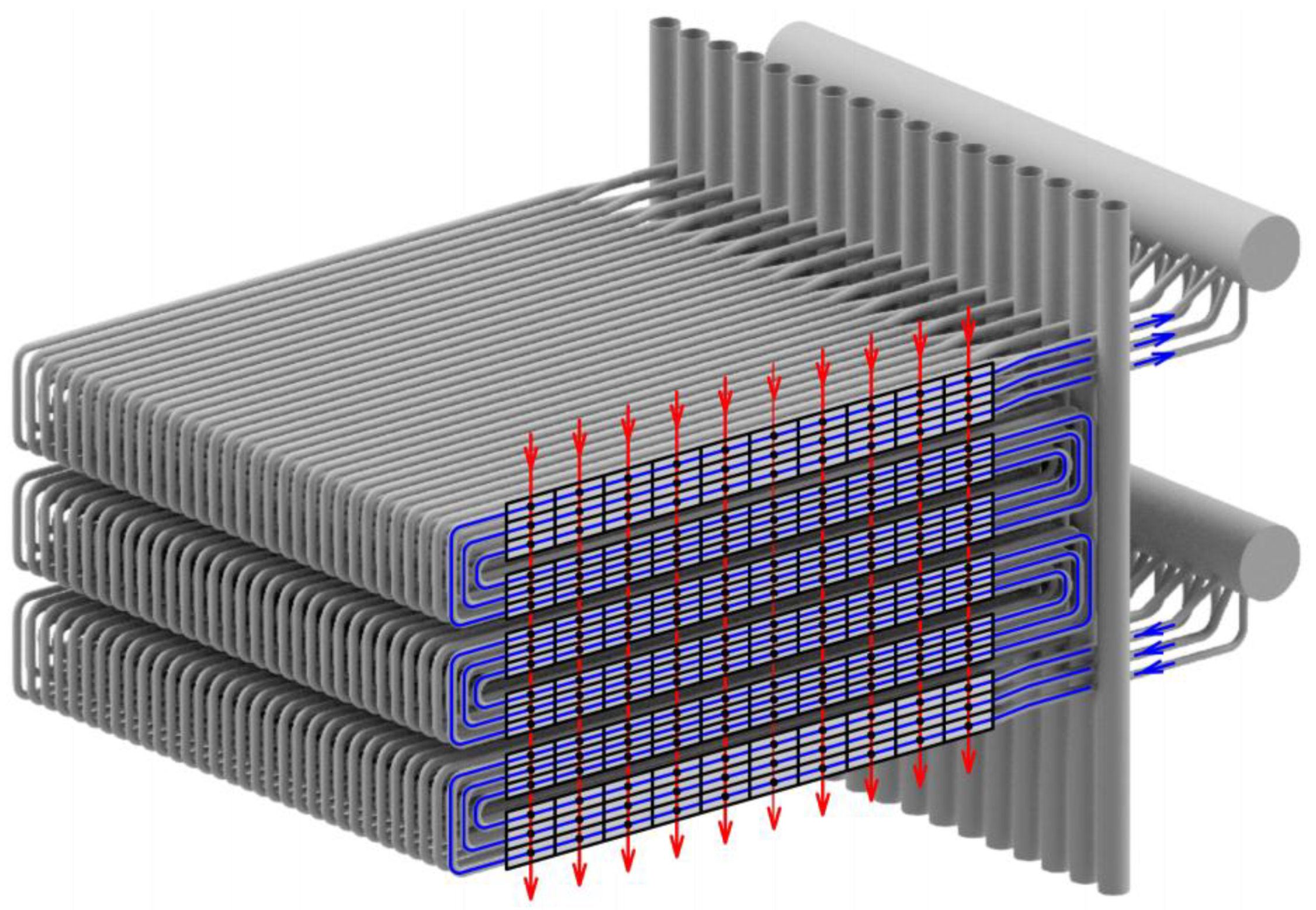
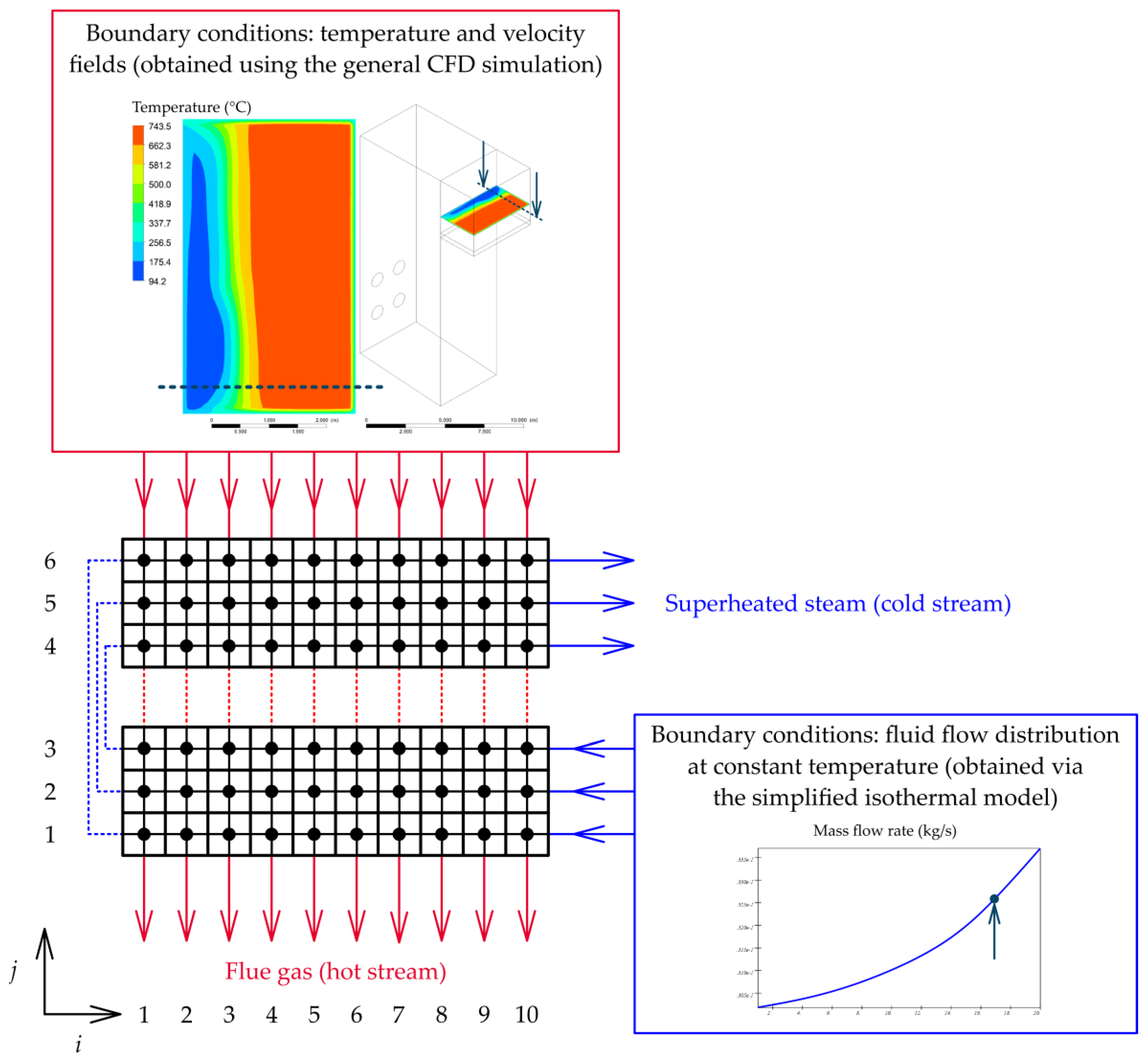
| Parameter | Value | ||
|---|---|---|---|
| Flow arrangement | Counter-crossflow | ||
| Number of tube passes | 6 | ||
| Tube bundle: | Number of tubes | 198 | |
| Number of tube columns | 66 | ||
| Number of tube rows | 3 | ||
| Hot Stream | Cold Stream | ||
| Flow data: | Fluid | Flue gas | Superheated steam |
| Mass flow rate (kg/s) | 17.8 | 16.7 | |
| Inlet temperature (°C) | 734.0 | 248.2 | |
| Outlet temperature (°C) | 495.5 | 369.0 | |
| jth Tube Element | ||||||||
|---|---|---|---|---|---|---|---|---|
| 1 | 2 | 3 | … | 8 | 9 | 10 | ||
| 6th pass | Tube 1 | 370.5 | 397.6 | 364.7 | … | 347.1 | 344.1 | 341.1 |
| Tube 2 | 369.0 | 366.2 | 363.5 | … | 346.8 | 343.9 | 341.1 | |
| Tube 3 | 367.6 | 365.0 | 362.4 | … | 346.5 | 343.8 | 341.1 | |
| 5th pass | Tube 3 | 316.5 | 319.1 | 321.7 | … | 337.3 | 339.8 | 342.4 |
| Tube 2 | 316.5 | 319.0 | 321.5 | … | 336.2 | 338.7 | 341.1 | |
| Tube 1 | 316.5 | 318.9 | 321.2 | … | 335.3 | 337.6 | 339.9 | |
© 2019 by the authors. Licensee MDPI, Basel, Switzerland. This article is an open access article distributed under the terms and conditions of the Creative Commons Attribution (CC BY) license (http://creativecommons.org/licenses/by/4.0/).
Share and Cite
Fialová, D.; Jegla, Z. Analysis of Fired Equipment within the Framework of Low-Cost Modelling Systems. Energies 2019, 12, 520. https://doi.org/10.3390/en12030520
Fialová D, Jegla Z. Analysis of Fired Equipment within the Framework of Low-Cost Modelling Systems. Energies. 2019; 12(3):520. https://doi.org/10.3390/en12030520
Chicago/Turabian StyleFialová, Dominika, and Zdeněk Jegla. 2019. "Analysis of Fired Equipment within the Framework of Low-Cost Modelling Systems" Energies 12, no. 3: 520. https://doi.org/10.3390/en12030520
APA StyleFialová, D., & Jegla, Z. (2019). Analysis of Fired Equipment within the Framework of Low-Cost Modelling Systems. Energies, 12(3), 520. https://doi.org/10.3390/en12030520






